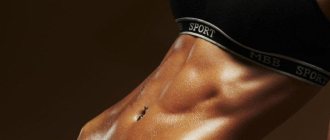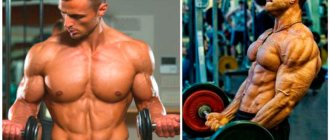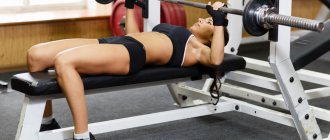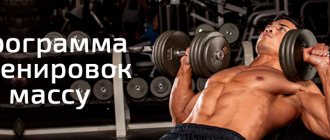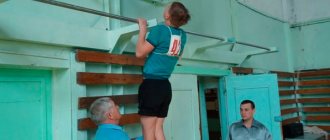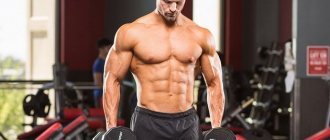Benefits of parallel bars training
Push-ups and parallel bars exercises are considered classics of strength training and are included in a significant number of programs. The advantage is the availability of the simulator and ease of use. The ability to adjust the load level is achieved simply by changing the position of the hands. Today, the apparatus is installed on almost any sports ground, and in the gym the presence of such a simulator is considered mandatory.
Dips work different muscles. What muscles work:
- biceps;
- chest muscles;
- triceps.
Today, there are two ways to perform the basic exercise on the uneven bars, the use of which determines the technique of push-ups on the uneven bars and which muscles work:
- the option of bending forward allows you to work the pectoral muscles;
- performing in a vertical position loads the triceps
Exercises on parallel bars directly or indirectly load the muscles of the shoulder girdle, pectoral muscles, back muscles and arms. In this case, the main load is received by the muscles responsible for the beautiful relief of the muscles - triceps, deltoid muscles, pectoral muscles. The main advantage of training on parallel bars is the ability to regulate the degree of load by simply changing the position of the hands or performing an exercise with weights.
How to do push-ups to train your chest muscles >>
Weight training program for uneven bars
In addition to the classic dips on the uneven bars that we talked about, you can also perform horizontal ones. They are no different from push-ups on the ground, but your arms and legs should be on the bars. By performing this exercise on the horizontal bar, you will have the opportunity to increase the range of motion. It is also worth recalling the possibility of training the abdominal muscles. To do this, you need to focus on straightened arms and then raise straight legs.
Now we'll talk about an eighteen-week weight training program for parallel bars. We do not promise you that you will achieve great success with its help in a short time, since this is simply not realistic. You won't be able to build muscle in a month or two.
If you find a method online whose authors make similar claims, do not believe them. For you to achieve a certain result, it will take a lot of time and you need to spend a lot of effort. However, if you wish, you will definitely solve the tasks.
After eighteen weeks, you will be able to see the first results, but then you will have to continue training on the parallel bars for weight. In addition to working on the horizontal bar, you will also have to use the crossbar. Don't forget about such an effective exercise as pull-ups.
At first, you can safely work with your own body weight. Gradually, the muscles will adapt to this load and you will have to increase it. To do this, you can use a special belt or vest, which are sold in sporting goods stores.
For the first three weeks, perform five sets of the same number of repetitions. After this, over the next three weeks, the number of repetitions should be increased to 10, and the number of sets should remain unchanged. And here is the training program itself:
- From 1 to 3 weeks - dips and pull-ups - 5 sets of 5 repetitions each (rest between sets is 120 seconds, and between repetitions 60 seconds).
- From 4 to 6 weeks - dips and pull-ups - 5 sets of 5 repetitions each (rest between sets is 90 seconds, and between repetitions 45 seconds).
- From 7 to 9 weeks - pull-ups - 7 sets of 3 repetitions each and - dips 6 sets of 5 repetitions (rest between exercises is 120-180 seconds).
- From weeks 10 to 12, the program of 1–3 weeks is repeated.
- From 12 to 15 weeks - repeat the program for 4-6 weeks.
- From 15 to 18 - repeat the program for 7-9 weeks.
Recommendations and rules of classes
A rationally and correctly selected set of exercises can show an incredible transformation and effectively work the muscles in a fairly short time. Experienced athletes say that such a set of exercises can replace strength training - incline press and bench press with a barbell in a lying position. Exercises using parallel bars are excellent preparation for later bench press exercises.
Before you start exercising on the apparatus, you definitely need to warm up your muscles and do stretching exercises, which will reduce the risk of injury. Before each session, you need to give your body time to rest for a couple of minutes.
If 15 repetitions in one approach are performed without much effort, then you should replace them with exercises using weights. To aggravate this, the following are used:
- athletic belt;
- backpack with cargo;
- special weights.
Execution technique
The technique of performing the exercise is very important. The emphasis on straight arms is considered the starting position. To prevent injury to the chest muscles, it is necessary to perform slow lowering, while tilting the upper body forward. When performing movements, it is necessary to maintain muscle tone and tension.
The lowering should be carried out in full until the moment is reached when the hands and armpits are at the same level. The time spent in the lower position should not exceed 2 seconds.
Push-ups and exercises on the uneven bars must be performed slowly and rhythmically; the technique does not allow the movement of the legs and swaying of the body, or attempts to perform the next pull-up with such movements. Sharp fixation can lead to friction of the bones, resulting in inflammation of the joint. Basic rules for the technique:
- inhalation is performed while lowering;
- exhalation is performed while moving upward;
- the chest should be in an extended position;
- shoulders should be laid back;
- the optimal depth option is considered to be a position in which the bottom of the chest falls just below the line of the bars;
- the arms are fully straightened, but overextension must not be allowed, otherwise the biceps can be stretched.
One of the important requirements for the apparatus is that the gap between the bars should not be large; the distance should slightly exceed the width of the shoulders. This exercise machine provides a comfortable grip. With a large distance between the bars, there is a high probability of injury to the muscles of the shoulder girdle.
How to do push-ups on parallel bars?
With this exercise you can effectively develop the muscles of the chest, arms and shoulder girdle. In addition, the abs, back and legs are also involved, although to a much lesser extent. By changing the technique of performing the exercise, you have the opportunity to shift the emphasis of the load to the required muscle group.
To get into the starting position for doing push-ups, you should stand between the bars and, holding them with your hands, push off from the ground. After jumping onto the uneven bars, you should hold your body with straightened arms. Bend your knees and cross your legs for added stability.
To get the most out of your triceps, you need to lean your body forward slightly. However, there is no need to bend over too much. Also make sure that your elbow joints are always near your body and do not spread them out to the sides. As you do push-ups, you should feel your triceps contracting.
To shift the emphasis of the load on the chest muscles, go lower. In the extreme position of the trajectory, the elbow joints should be bent at an angle of 30 degrees. It should be said that when performing any power movement, you need to learn to feel the work of the muscles. This may not happen right away, but over time this skill will come.
Basic complex for beginners
For the success of training, regularity of training, a correctly chosen pattern of push-ups and parallel bars, and a gradual transition to higher loads are important. A beginner's dip program should include performing the exercise at the very beginning of your workout, when you have sufficient energy and strength. At the end of the workout, even with a strong desire to perform the exercise correctly, it is unlikely to be possible. To make the exercise easier at the initial stage, instructors recommend bending your legs slightly.
The duration of training should not be more than 1.5 hours and there should be a break of at least 1 day between them. For beginners it is recommended:
- perform several passes on the projectile;
- calculate strength for 4-5 approaches per workout;
- Perform 8-15 repetitions in each approach.
To maintain the load on the lower chest when lifting, it is necessary to maintain an inclined position of the torso forward. The exercise can be performed as many times as you have patience and strength. If it is impossible to complete a full lift, you must try to do it to the maximum height.
About training for beginners >>
Complex for professionals
It is recommended that the complex program for professionals include parallel bar push-ups. As your physical fitness increases, you can gradually increase the load and increase the number of repeated movements during the approach to the extent that your patience and strength endurance will suffice. The optimal pattern of push-ups and exercises on the uneven bars is considered to be a number of repetitions from 8 to 15. In the training program for experienced athletes, such exercises on the uneven bars can be included closer to the end of the training.
If the exercise is performed with weights, it is recommended to perform the workout according to the scheme of 6-8 repetitions. Typically, the total number of repetitions and reps to perform is calculated based on a set of compound exercises.
For example, with the classic training program scheme and the presence of 3 sets of 5 repetitions of the bench press, the dip pattern consists of 3 sets of 8 repetitions, that is, the number of push-ups is always 3 or 4 repetitions more than in the bench press.
The technique for performing the basic exercise is similar:
- take a starting position between the parallel bars with straightened arms and a neutral grip;
- take a breath and slowly begin to bend your elbows, lowering yourself down;
- return to the starting position and inhale at the most difficult point of the lift.
Technical nuances for trained athletes
Exercises on parallel bars, subject to a number of rules, allow you to work out certain muscle groups, for which you just need to correctly redistribute the load. There are the following nuances of the push-up technique:
- exercises on standard parallel bars allow you to pump up the pectoral muscles, while the knees should be bent and raised towards the body, the elbows should be clearly separated;
- triceps dips are performed with the arms held closer to the torso, the elbows should be directed back, the legs should be straight;
- to enhance the work of the biceps, you need to take the starting position;
- when performing push-ups on uneven bars of a slightly wider width, you can provide a greater load on the chest muscles;
- To work out the pectoral muscles, weights placed on the belt are recommended;
- The abdominal muscles are effectively trained by raising the knees while hanging and the upper part of the body, sitting on parallel bars with the legs hooked.
The depth of push-ups depends only on strength and flexibility. Professionals should not get carried away, since dips on the parallel bars are strongly aimed at the triceps, and overloading them can later lead to problems in performing the bench press.
Experienced athletes can afford to replace the basic exercise with its variations. The most commonly used are partial repetitions and a stepped push-up pattern when performing the parallel bars exercise. Partial reps involve doing push-ups only halfway and then returning to the starting position. Such push-ups allow you to load muscles that have not yet reached the point of complete fatigue. Stepped training involves decreasing the load with each repetition.
A training program that includes push-ups performed on uneven bars in a set of exercises will allow you to pump up the muscles of your arms, chest and shoulder girdle in a fairly short period of time, creating a spectacular and attractive sculpted torso.
Dips on parallel bars: how to use universal gymnastic equipment 81 photos and tips
Athletes and trainers who are familiar with multi-joint exercises say that they are classics of bodybuilding. If you are planning to develop muscles in the chest and arms (in particular, triceps), then you cannot do without dips, which are the main exercise in this area.
A personal plan for parallel bar push-ups drawn up by the trainer loads certain muscle groups and with regular exercise, the body will gain not only beauty, but also strength, elasticity and fit.
This type of exercise was actively used in the second half of the 20th century to work out the chest muscles. Nowadays, training on parallel bars is also widespread, especially for bodybuilders.
Particularly popular is the bench press bench, exercises on which also strengthen the arms, however, the bench loads the chest much less than the same parallel bars.
Photos of dips clearly demonstrate how the exercise loads and strengthens the upper body.
Experts highlight the main advantage of dips - targeted development of muscle groups. Progress in this area gives a strong impetus to a variety of pressing movements, both lying and standing.
After classes, the chest contours will noticeably stand out, the shoulders will visually become wider, and the deltoids will become larger. In addition, the above exercises will have a positive effect on your posture and figure.
It is only from the top point that you need to start warming up. It is very dangerous to start lifting the body from the bottom point of the position, because the muscles are not properly stretched and the body is not ready.
For increased efficiency, you can perform weighted dips. More weight means additional stress on the muscles. Weights, chains, weights, etc. are used as weights. They can be attached to the shoulders, lower back, chest or neck.
You also need to avoid curvature of the cervical spine. Keep your chin parallel to the floor. It is better to straighten your legs as much as possible. If you feel more comfortable, you can cross your legs while doing push-ups. At the highest point of the exercise, the elbows should be fully straightened.

